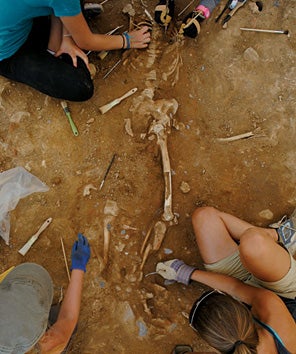Caitlin stone discovered the remnants of a soup bowl that measured 16 inches wide. sarah elgradawy pulled a skull out of a tomb built somewhere around 2,000 years ago. The senior anthropology students both excavated gravesites this past summer, though they were half a world apart when completing their digs. Stone was busy investigating human remains around an old Italian monastery, while Elgradawy worked in the thin air of Peru’s Andean highlands to map an ancient settlement.
Each of their trips was helped made possible by the Catherine Wood Parker Scholarship, which was created by
Parker’s daughter, Chris Heidenreich, to honor her mother’s interest in education and anthropology. Parker, who attended Vassar College before eventually moving back to South Carolina, was a regular volunteer at the Charleston Museum. She passed away in 1995.
For Stone, the scholarship made her third trip to Italy more affordable. Elgradawy used the scholarship to purchase a cold-weather sleeping bag and other gear and clothing necessary for living in the Andes for a month.
Elgradawy worked in a field school outside the small town of Hualcayán at a site that was part of the Recuay culture.
At this small settlement, there was an aboveground tomb, called a chullpa, which Elgradawy helped excavate with a team of other students and archaeologists. Historically, she explains, mummified bodies were kept in the tomb and temporarily removed by villagers to attend festivals and feasts. Few of these mummified skeletons are intact today.
Elgradawy’s primary task, though, was to help map the settlement using geographic information systems (GIS). She explored the site with a machine called a total station that could pinpoint exact latitude and longitude, creating maps that showed the location of walls and
“The time I spent working at the Badia Pozzeveri was one of the most rewarding and enriching experiences of my life.”
– Caitlin Stone
terraces in the settlement, which thrived between 900 B.C. and A.D. 600.
“I really enjoyed going out into the field with the total station and analyzing the landscape in order to create maps of the site,” says Elgradawy.
In Altopascio, Italy, Stone worked at the Badia Pozzeveri, an 11th-century abbey located beside a pilgrimage road that is still in use today. The abbey, which was
abandoned by monks by the 15th century, was used as a cholera hospital in the 19th century. Many of the excavated gravesites surrounding the abbey contain cholera victims, and she and her colleagues discovered lime deposits that contained the impressions of wrinkles from the deceased’s skin or burial shrouds.
Stone focused on a gravesite behind the church, near its altar. The soil there was acidic, however, and most skeletons had disintegrated.
“We got one, but all we had left was teeth,” says Stone. “But we could see where the body was buried.”
Besides excavation of gravesites, Stone gained experience with GIS and worked in labs that cleaned and reconstructed both skeletons and ancient pottery. She made a point to travel through Italy, taking weekend trips to Florence, Lucca, Cinque Terre and Siena. She also packed in a four- day trip to Rome and Pompeii.
Though exhausted by long days in the field, too, Elgradawy mustered energy to horseback ride in the Andes, hike to a glacial lake and, to end her trip, made an excursion to Machu Picchu. Neither student wanted to miss out on the trips of a lifetime and sights located both above and below ground.
“The time I spent working at the Badia Pozzeveri was one of the most rewarding and enriching experiences of my life,” says Stone. “Not only was I immersed in a culture that I always loved, but I was also given the chance to spend time with many talented students, instructors and lecturers who shared a common interest and enthusiasm for anthropology and bioarchaeology.”
And those possibilities for travel and adventure would not have been possible without the generosity of Mrs. Heidenreich and the Catherine Wood Parker Scholarship.







